A New Insight into Shale-Gas Accumulation Conditions and Favorable Areas of the Xinkailing Formation in the Wuning Area, North-West Jiangxi, China
Abstract
:1. Introduction
2. Geological Setting
2.1. Overview
2.2. Shale-Distribution Characteristics
3. Data and Methodology
4. Results
4.1. Hydrocarbon-Generation Conditions
4.2. Reservoir Conditions
4.2.1. Permeability and Porosity
4.2.2. Reservoir Storage-Space Types
4.2.3. Pore-Structure Characteristics
4.2.4. Mineral Composition and Lithofacies
4.2.5. Isothermal Adsorption Characteristics
5. Discussion
5.1. The Xinkailing Shale Gas-Bearing Potential
5.2. The Optimization of Favorable Areas
- (1)
- Previous research has clarified that the key factors for the accumulation of shale gas are the thickness and sub-surface depth of organic-rich shale [47]. Organic-rich shale must be thick enough to form effective source rocks and reservoirs. Sub-surface depth not only has a significant effect on the production and accumulation of shale gas, but also directly impacts shale-gas development costs. The proper conditions of sub-surface depth with moderate temperature and pressure can trigger shale to generate hydrocarbons (including biogenic gas and thermogenic gas). It is unfavorable to accumulate free gas at greater sub-surface depths because large depth leads to greater pressure, in turn leading to smaller porosity. In the Wuning area, research results showed that the thickness of organic-rich shale increased from west towards east, ranging from 10 m to 80 m. The sub-surface depth of the syncline wings was shallower than at the core of the syncline. The lower limit of thickness was determined to be 30 m during the process of optimizing favorable areas. The sub-surface depth of the Xinkailing formation in the whole area ranged from 500 m to 3000 m, which was a favorable depth overall.
- (2)
- TOC is a significant influencing factor of hydrocarbon-generating intensity, which determines the hydrocarbon-generating quantity [48] and plays an important role in the control of shale-gas accumulation. In addition, TOC also has a significant effect on shale gas by preserving gas due to the solution and adsorption effects (Figure 12). In Wuning, the overall TOC was greater than 1%. TOC appeared to be higher in the middle of the area, but decreased toward the two sides. The lower limit of TOC was determined to be 2% during the process of optimizing favorable areas.
- (3)
- In thermogenic shale-gas reservoirs, hydrocarbons are generated by the interaction of time, temperature and pressure. Kerogen maturity could not only predict hydrocarbon-generating potential, but also influences adsorption gas volume (Figure 13). In Wuning, the degree of thermal evolution showed a trend of “west high, east low” and “core high, side low”. The upper limit of organic matter maturity was determined to be 3% during favorable-area optimization.
- (4)
- Brittle-mineral content is a key parameter influencing the effect of hydraulic fracturing treatment [17]. In Wuning, the brittle-mineral content of Xinkailing-formation shale ranges from 51% to 64% (average 56.06%) which can make the shale easily fractured.
- (5)
- Preservation conditions also exert significant effects on the accumulation of shale gas [16], which are determined by the intensity of tectonic movement. To determine the shale-gas resources potential and exploitation direction it is important to comprehensively analyze reservoir-preservation conditions. The optimization of structurally favorable areas within the Xinkailing formation in Wuning was conducted under consideration of tectonic location, attitude of stratum (direction and angle of dip), distance from outcrops to the target layer, and the development of fractures. The optimization results showed that syncline cores are favorable areas for shale-gas accumulation due to their greater distance from the target layer outcrop, gentle dip angle, and poor fault development.
6. Conclusions
Acknowledgments
Author Contributions
Conflicts of Interest
References
- Curtis, J.B. Fractured shale-gas systems. AAPG Bull. 2002, 86, 1921–1938. [Google Scholar]
- Montgomery, S.L.; Jarvie, D.M.; Bowker, K.A. Mississippian Barnett Shale, Fort Worth basin, north-central Texas: Gas-shale play with multi–trillion cubic foot potential. AAPG Bull. 2005, 89, 155–175. [Google Scholar] [CrossRef]
- Bowker, K.A. Barnett Shale gas production, Fort Worth Basin: Issues and discussion. AAPG Bull. 2007, 91, 523–533. [Google Scholar] [CrossRef]
- Tang, X.L.; Jiang, Z.X.; Li, Z. The effect of the variation in material composition on the heterogeneous pore structure of high-maturity shale of the Silurian Longmaxi formation in the southeastern Sichuan Basin, China. J. Nat. Gas Sci. Eng. 2015, 23, 464–473. [Google Scholar] [CrossRef]
- Zhou, D.S.; Xu, L.F.; Pan, J.P. Prospect of shale gas exploration in the Upper Permian Longtan Formation in the Yangtze Massif. Nat. Gas Ind. 2012, 32, 6–10. [Google Scholar]
- Yang, F.; Ning, Z.F.; Liu, H.Q. Fractal characteristics of shales from a shale gas reservoir in the Sichuan Basin, China. Fuel 2014, 115, 378–384. [Google Scholar] [CrossRef]
- Liu, X.J.; Xiong, J.; Liang, L.X. Investigation of pore structure and fractal characteristics of organic-rich Yanchang formation shale in central China by nitrogen adsorption/desorption analysis. J. Nat. Gas Sci. Eng. 2015, 22, 62–72. [Google Scholar] [CrossRef]
- Li, P.; Jiang, Z.X.; Zheng, M. Estimation of shale gas adsorption capacity of the Longmaxi Formation in the Upper Yangtze Platform, China. J. Nat. Gas Sci. Eng. 2016, 34, 1034–1043. [Google Scholar] [CrossRef]
- Guo, T.L.; Zhang, H.R. Formation and enrichment mode of Jiaoshiba shale gas field, Sichuan Basin. Pet. Explor. Dev. 2014, 41, 31–40. [Google Scholar] [CrossRef]
- Zhang, J.C.; Yang, C.; Chen, Q. Deposition and distribution of potential shales in China. Earth Sci. Front. 2016, 23, 74–86. [Google Scholar]
- Liang, D.G.; Guo, T.L.; Bian, L.Z. Some progress on studies of hydrocarbon generation and accumulation in marine sedimentary regions, southern China (Part 3): Controlling factors on the sedimentary facies and development of Paleozoic marine source rocks. Mar. Orig. Pet. Geol. 2009, 14, 1–19. [Google Scholar]
- Liang, D.G.; Guo, T.L.; Chen, J.P. Some progress on studies of hydrocarbon generation and accumulation in marine sedimentary regions, southern China. (Part 1): Distribution of four suits of regional marine source rocks. Mar. Orig. Pet. Geol. 2008, 13, 1–16. [Google Scholar]
- Liang, D.G.; Guo, T.L.; Chen, J.P. Some progress on studies of hydrocarbon generation and accumulation in marine sedimentary regions, southern China. (Part 2): Geochemical characteristics of four suits of regional marine source rocks, south China. Mar. Orig. Pet. Geol. 2009, 14, 1–15. [Google Scholar]
- Liang, C.; Jiang, Z.X.; Zhang, C.M. The shale characteristics and shale gas exploration prospects of the Lower Silurian Longmaxi shale, Sichuan Basin, South China. J. Nat. Gas Sci. Eng. 2014, 21, 636–648. [Google Scholar] [CrossRef]
- Tan, J.Q.; Horsfield, B.; Fink, R. Shale Gas Potential of the Major Marine Shale Formations in the Upper Yangtze Platform, South China, Part III: Mineralogical, Lithofacial, Petrophysical and Rock Mechanical Properties. Energy Fuels 2014, 28, 2322–2342. [Google Scholar] [CrossRef]
- Wang, R.Y.; Ding, W.L.; Gong, D.J. Gas preservation conditions of marine shale in northern Guizhou area: A case study of the Lower Cambrian Niutitang Formation in the Cen’gong block, Guizhou Province. Oil Gas Geol. 2016, 37, 45–55. [Google Scholar]
- Jin, Z.J.; Hu, Z.Q.; Gao, B. Controlling factors on the enrichment and high productivity of shale gas in the Wufeng-Longmaxi Formations, southeastern Sichuan Basin. Earth Sci. Front. 2016, 23, 1–10. [Google Scholar]
- Tuo, J.C.; Wu, C.J.; Zhang, M.F. Organic matter properties and shale gas potential of Paleozoic shales in Sichuan Basin, China. J. Nat. Gas Sci. Eng. 2016, 28, 434–446. [Google Scholar] [CrossRef]
- Guo, X.S.; Hu, D.F.; Wen, Z.D. Major factors controlling the accumulation and high productivity in marine shale gas in the Lower Paleozoic of Sichuan Basin and its periphery: A case study of the Wufeng-Longmaxi Formation of Jiaoshiba area. Geol. China 2014, 41, 893–901. [Google Scholar]
- Guo, T.L. Discovery and characteristics of the Fuling shale gas field and its enlightenment and thinking. Earth Sci. Front. 2016, 23, 29–43. [Google Scholar]
- Cai, Z.R.; Xia, B.; Huang, Q.T. Comparative study of the tectonic setting on the formation and preservation of Paleozoic shale gas between the Upper Yangtze and the Lower Yangtze platforms. Nat. Gas Geosci. 2015, 26, 1446–1454. [Google Scholar]
- Pang, F.; Bao, S.J.; Ren, S.M. Shale gas accumulation conditions and favorable areas of the lower Cambrian in Xiuwu basin. J. Northeast Pet. Univ. 2014, 38, 23–30. [Google Scholar]
- Liu, W.W.; Tian, J.C.; Lin, X.B. Characteristics and significance of mineral compositions in Lower Cambrian black shale from Xiuwu basin, Jiangxi, China. J. Chengdu Univ. Technol. Sci. Technol. Ed. 2015, 42, 90–97. [Google Scholar]
- Huang, X.B. Basic features of decollement structures in the Xiushui-Yongxiu area of northwest Jiangxi. Jiangxi Geol. 2001, 15, 81–86. [Google Scholar]
- Mort, H.P.; Adatte, T.; Keller, G. Organic carbon deposition and phosphorus accumulation during Oceanic Anoxic Event 2 in Tarfaya, Morocco. Cretac. Res. 2008, 29, 1008–1023. [Google Scholar] [CrossRef]
- Hemmesch, N.T.; Harris, N.B.; Mnich, C.A. A sequence stratigraphic framework for the Upper Devonian Woodford Shale, Permian Basin, west Texas. AAPG Bull. 2014, 98, 23–47. [Google Scholar] [CrossRef] [Green Version]
- Feng, G.X.; Chen, S.J. Relationship between the reflectance of bitumen and vitrinite in rock. Nat. Gas Ind. 1988, 8, 20–25. [Google Scholar]
- Qin, J.Z.; Li, Z.M.; Teng, G.E. A study paleo-geothermometer of high mature marine sequences in South China. Oil Gas Geol. 2009, 30, 608–618. [Google Scholar]
- Zhang, J.C.; Lin, L.M.; Li, Y.X. The method of shale gas assessment: Probability volume method. Earth Sci. Front. 2012, 19, 184–191. [Google Scholar]
- Jarvie, D.M.; Hill, R.J.; Ruble, T.E. Unconventional shale-gas systems: The Mississippian Barnett Shale of north-central Texas as one model for thermogenic shale-gas assessment. AAPG Bull. 2007, 91, 475–499. [Google Scholar] [CrossRef]
- Cardott, B.J. Thermal maturity of Woodford Shale gas and oil plays, Oklahoma, USA. Int. J. Coal Geol. 2012, 103, 109–119. [Google Scholar] [CrossRef]
- Huang, J.L.; Zou, C.N.; Li, J.Z. Shale gas generation and potential of the Lower Cambrian Qiongzhusi Formation in Southern Sichuan Basin, China. Pet. Explor. Dev. 2012, 39, 69–75. [Google Scholar] [CrossRef]
- Xie, D.; Xu, T.J.; Zhang, W.K. Organic geochemical characteristics of Qiongzhusi Formation in Jingyan-Qianwei area. Nat. Gas Technol. Econ. 2015, 9, 1–4. [Google Scholar]
- Jiang, Y.Q.; Song, Y.T.; Qi, L. Fine lithofacies of China’s marine shale and its logging prediction: A case study of the Lower Silurian Longmaxi marine shale in Weiyuan area, southern Sichuan Basin, China. Earth Sci. Front. 2016, 23, 107–118. [Google Scholar]
- Nie, H.K.; Zhang, J.C. Research on types and characteristics of shale gas reservoir: A case study of Lower Paleozoic in and around Sichuan Basin. Pet. Geol. Exp. 2011, 33, 219–225. [Google Scholar]
- Slatt, R.M.; Brien, N.R.O. Pore types in the Barnett and Woodford gas shales: Contribution to understanding gas storage and migration pathways in fine-grained rocks. AAPG Bull. 2011, 95, 2017–2030. [Google Scholar] [CrossRef]
- Zeng, L.B.; Lyu, W.Y.; Li, J. Natural fractures and their influence on shale gas enrichment in Sichuan Basin, China. J. Nat. Gas Sci. Eng. 2016, 30, 1–9. [Google Scholar] [CrossRef]
- Ross, D.J.K.; Bustin, R.M. The importance of shale composition and pore structure upon gas storage potential of shale gas reservoirs. Mar. Pet. Geol. 2009, 26, 916–927. [Google Scholar] [CrossRef]
- Hu, Z.Q.; Du, W.; Peng, Y.M. Microscopic pore characteristics and the source-reservoir relationship of shale-A case study from the Wufeng and Longmaxi Formations in Southeast Sichuan Basin. Oil Gas Geol. 2015, 36, 1001–1008. [Google Scholar]
- Sing, K.S.W. Reporting physisorption data for gas/solid systems with special reference to the determination of surface area and porosity (Recommendations 1984). Pure Appl. Chem. 1982, 54, 2201–2218. [Google Scholar] [CrossRef]
- Rouquerol, J.; Avnir, D.; Everett, D.H. Guidelines for the Characterization of Porous Solids. Pure Appl. Chem. 2014, 87, 1–9. [Google Scholar]
- Clarkson, C.R.; Solano, N.; Bustin, R.M. Pore structure characterization of North American shale gas reservoirs using USANS/SANS, gas adsorption, and mercury intrusion. Fuel 2013, 103, 606–616. [Google Scholar] [CrossRef]
- Lin, B.T.; Chen, M.; Jin, Y. Modeling pore size distribution of southern Sichuan shale gas reservoirs. J. Nat. Gas Sci. Eng. 2015, 26, 883–894. [Google Scholar] [CrossRef]
- Wu, L.Y.; Hu, D.F.; Lu, Y.C. Advantageous shale lithofacies of Wufeng Formation-Longmaxi Formation in Fuling gas field of Sichuan Basin, SW China. Pet. Explor. Dev. 2016, 43, 208–217. [Google Scholar] [CrossRef]
- Chen, K.; Zhang, J.C.; Tang, X. Main controlling factors on shale adsorption capacity of the Lower Silurian Longmaxi Formation in western Hunan-Hubei area. Oil Gas Geol. 2016, 37, 23–29. [Google Scholar]
- Ross, D.J.K.; Bustin, R.M. Characterizing the shale gas resource potential of Devonian-Mississippian strata in the Western Canada sedimentary basin: Application of an integrated formation evaluation. AAPG Bull. 2008, 92, 87–125. [Google Scholar] [CrossRef]
- Liu, H.L.; Wang, H.Y.; Fang, C.H. The formation mechanism of over-pressure reservoir and target screening index of the marine shale in the South China. Earth Sci. Front. 2016, 23, 48–54. [Google Scholar]
- Wang, Z.P.; Zhang, J.C.; Sun, R. The gas-bearing characteristics analysis of the Longtan Formation transitional shale in Well Xiye 1. Earth Sci. Front. 2015, 22, 243–250. [Google Scholar]
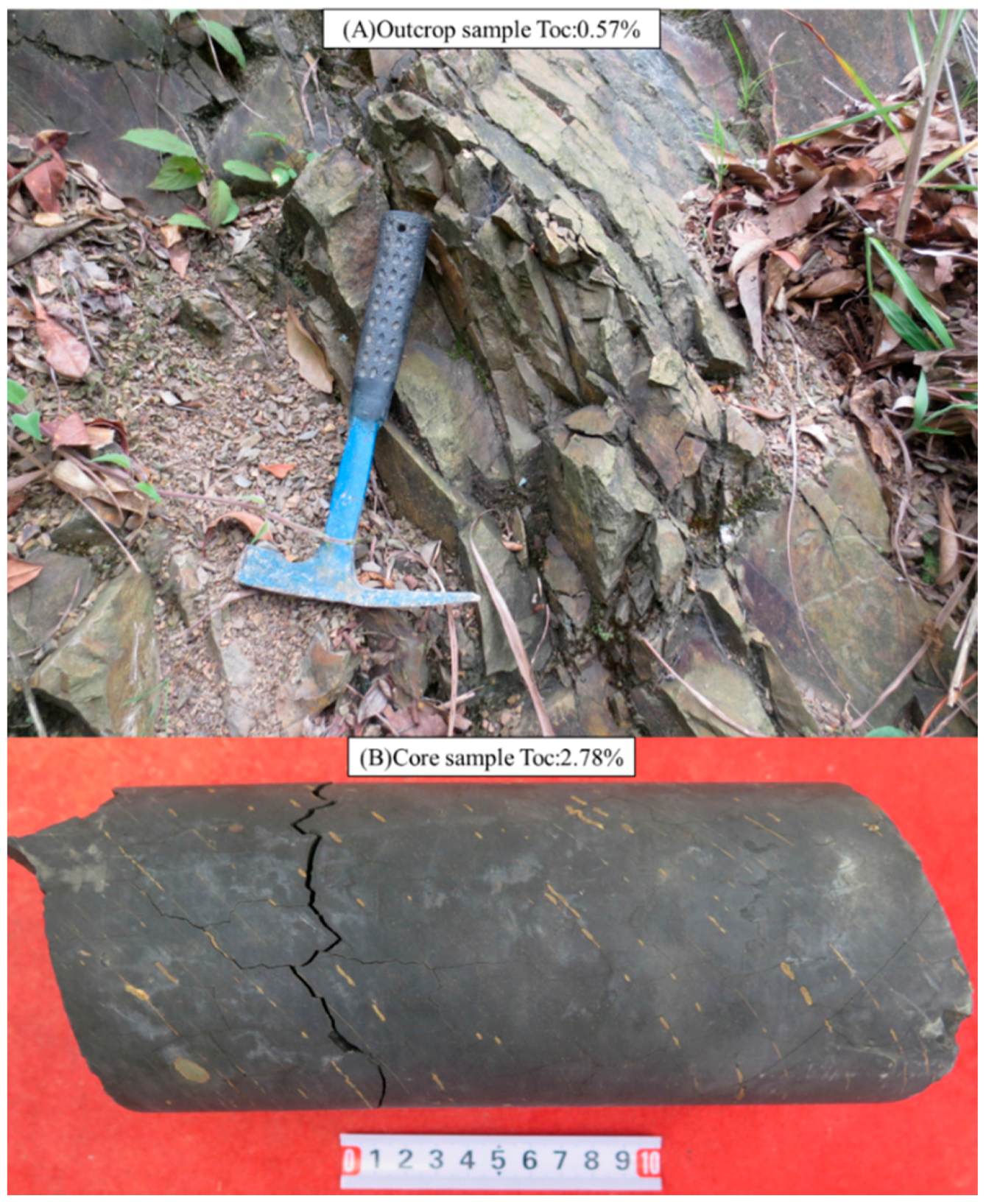
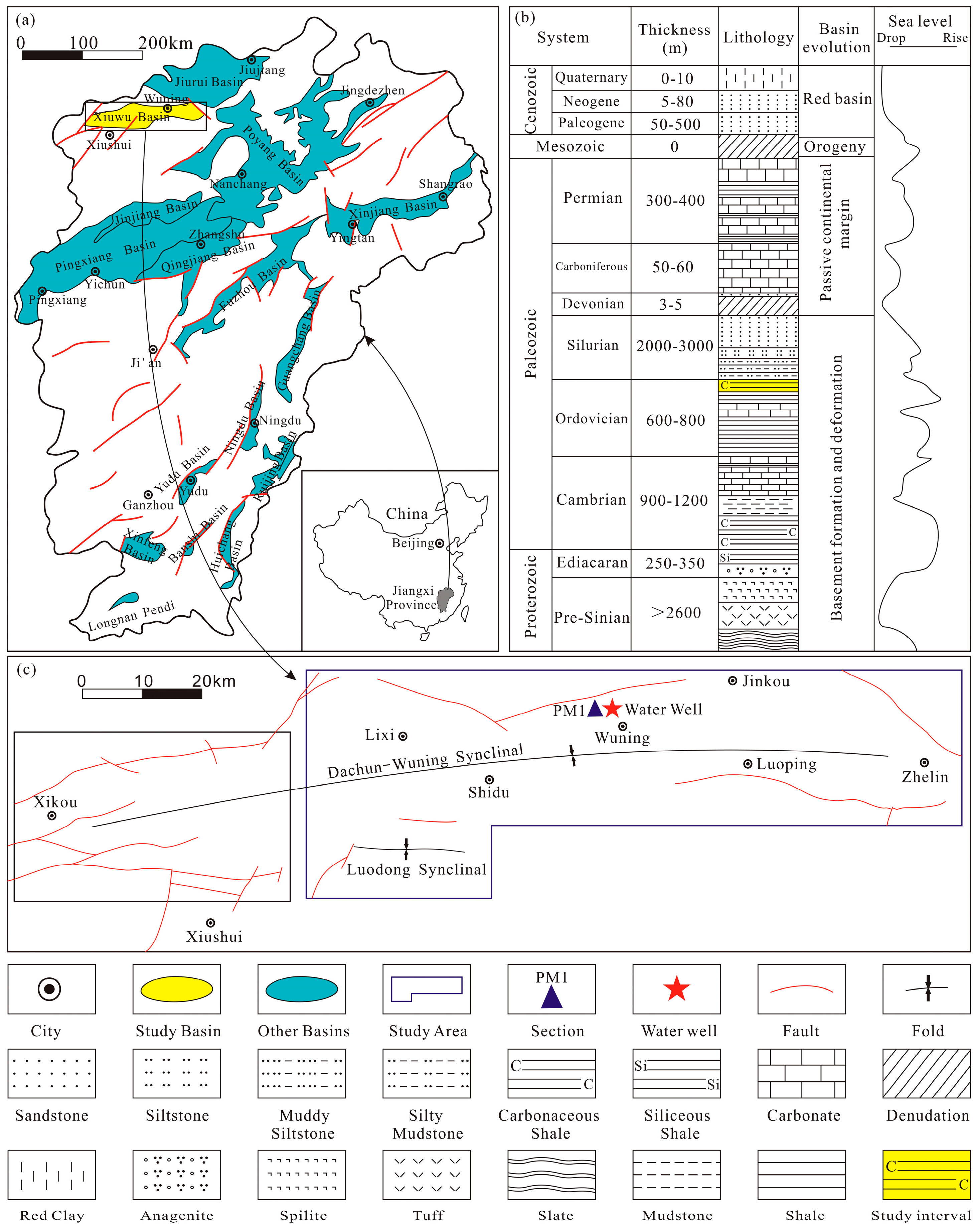


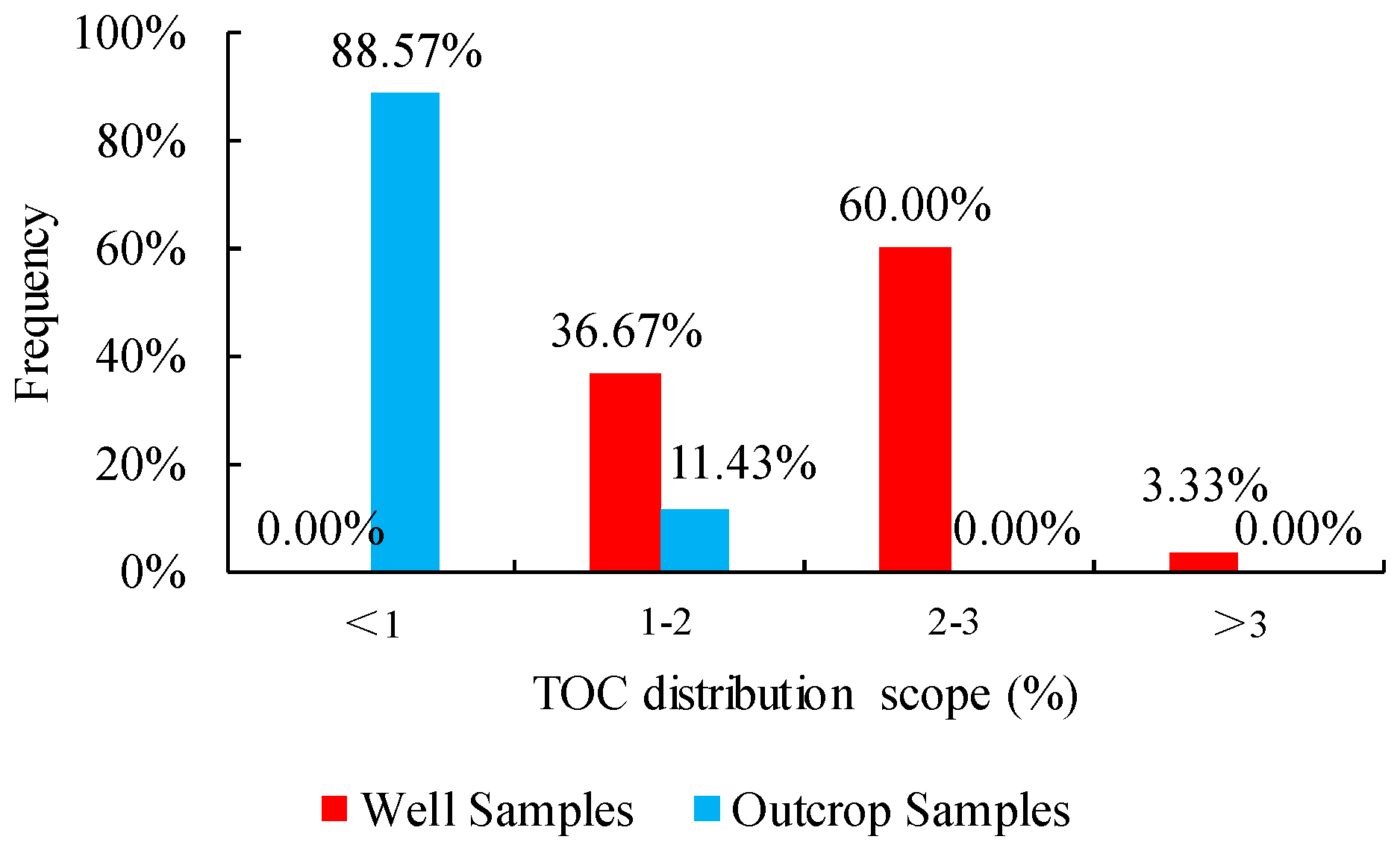
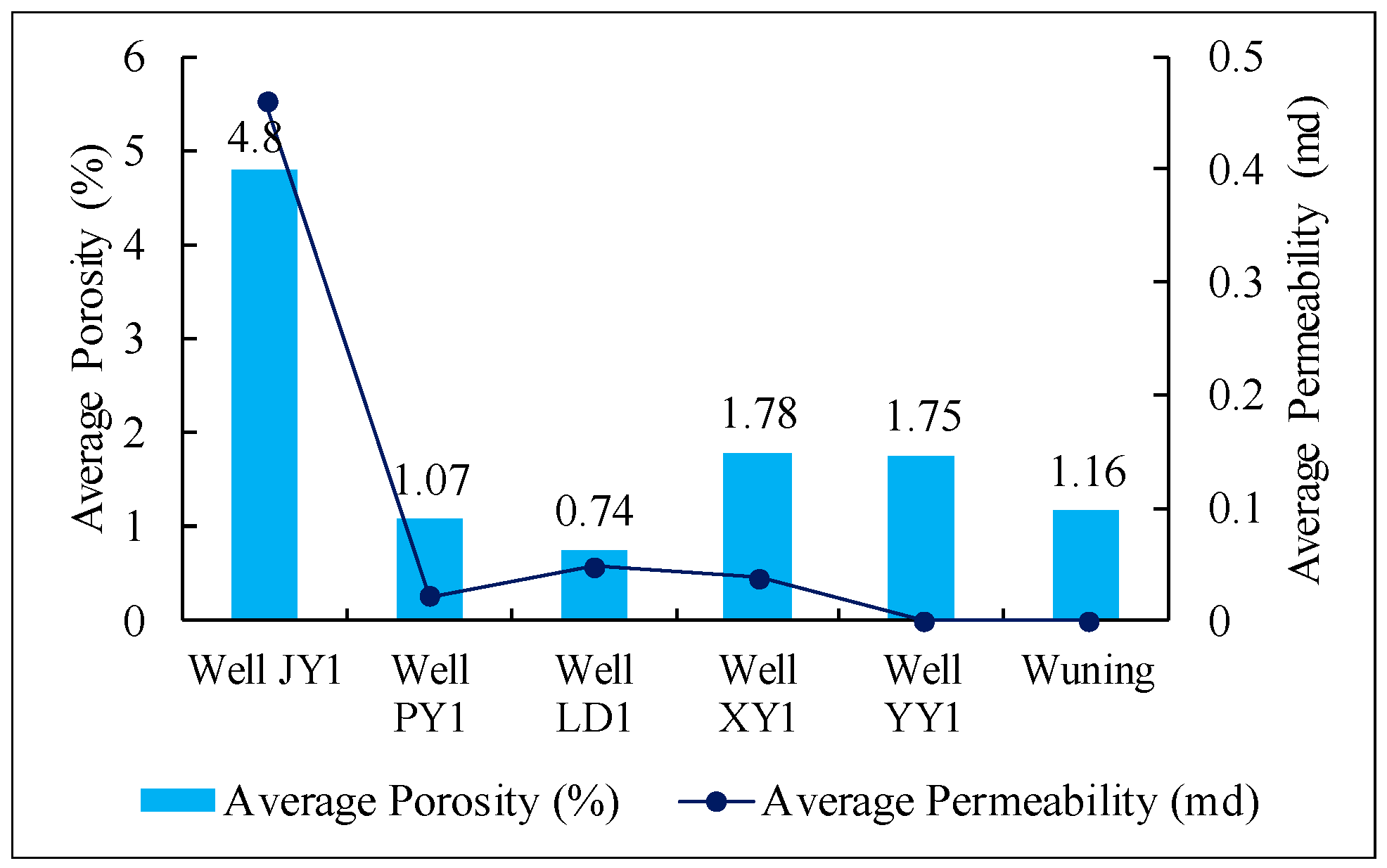
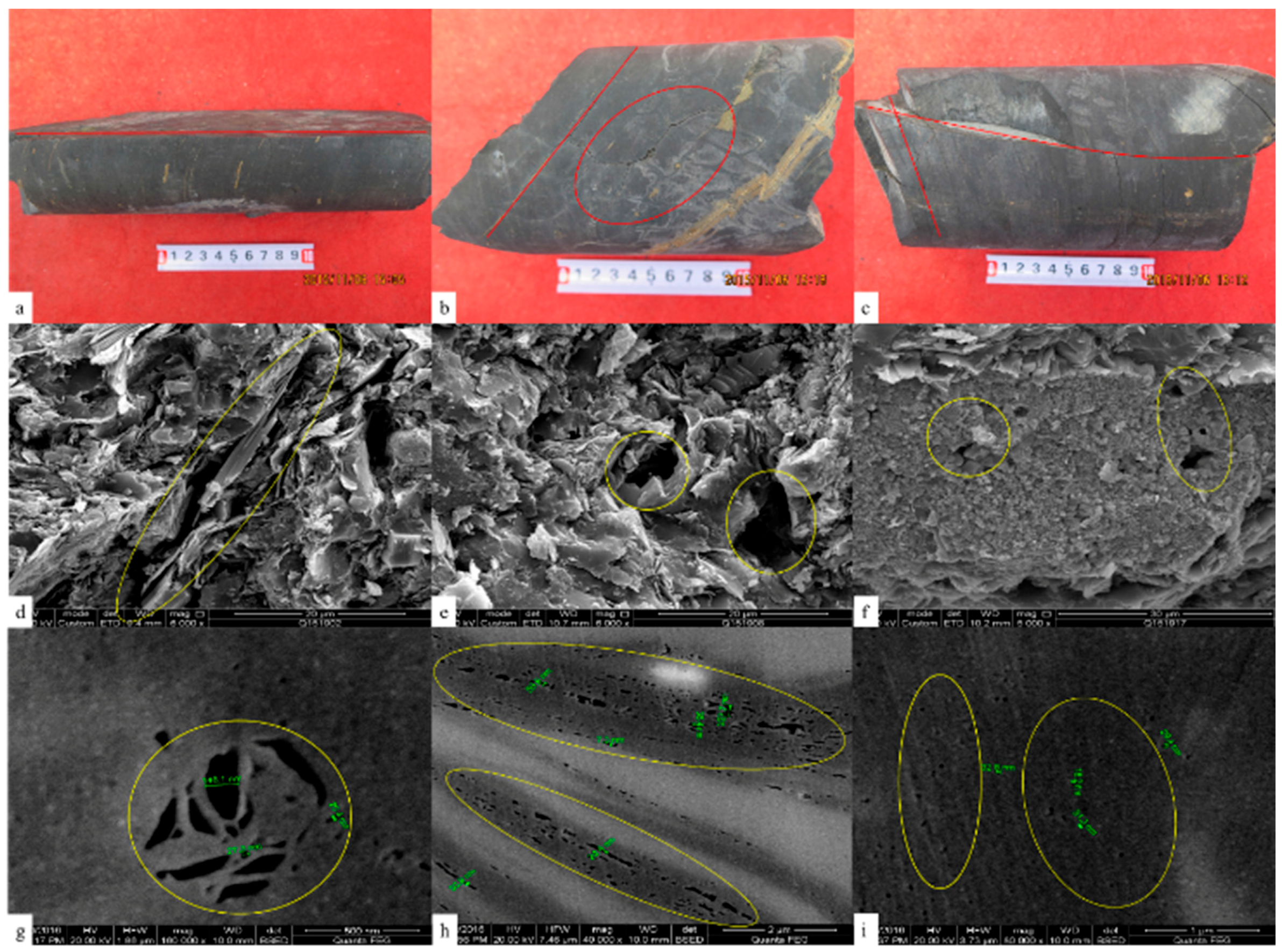
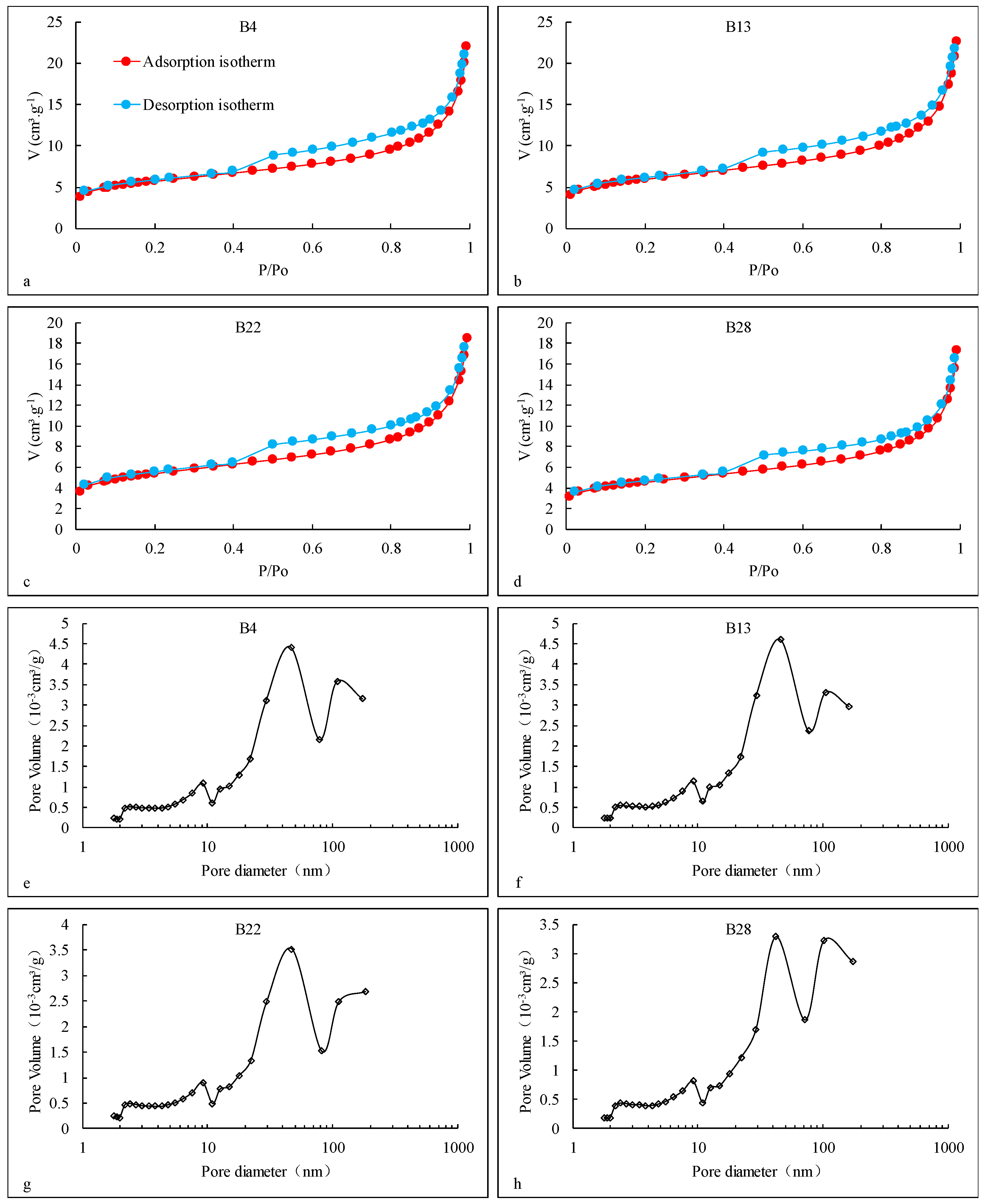

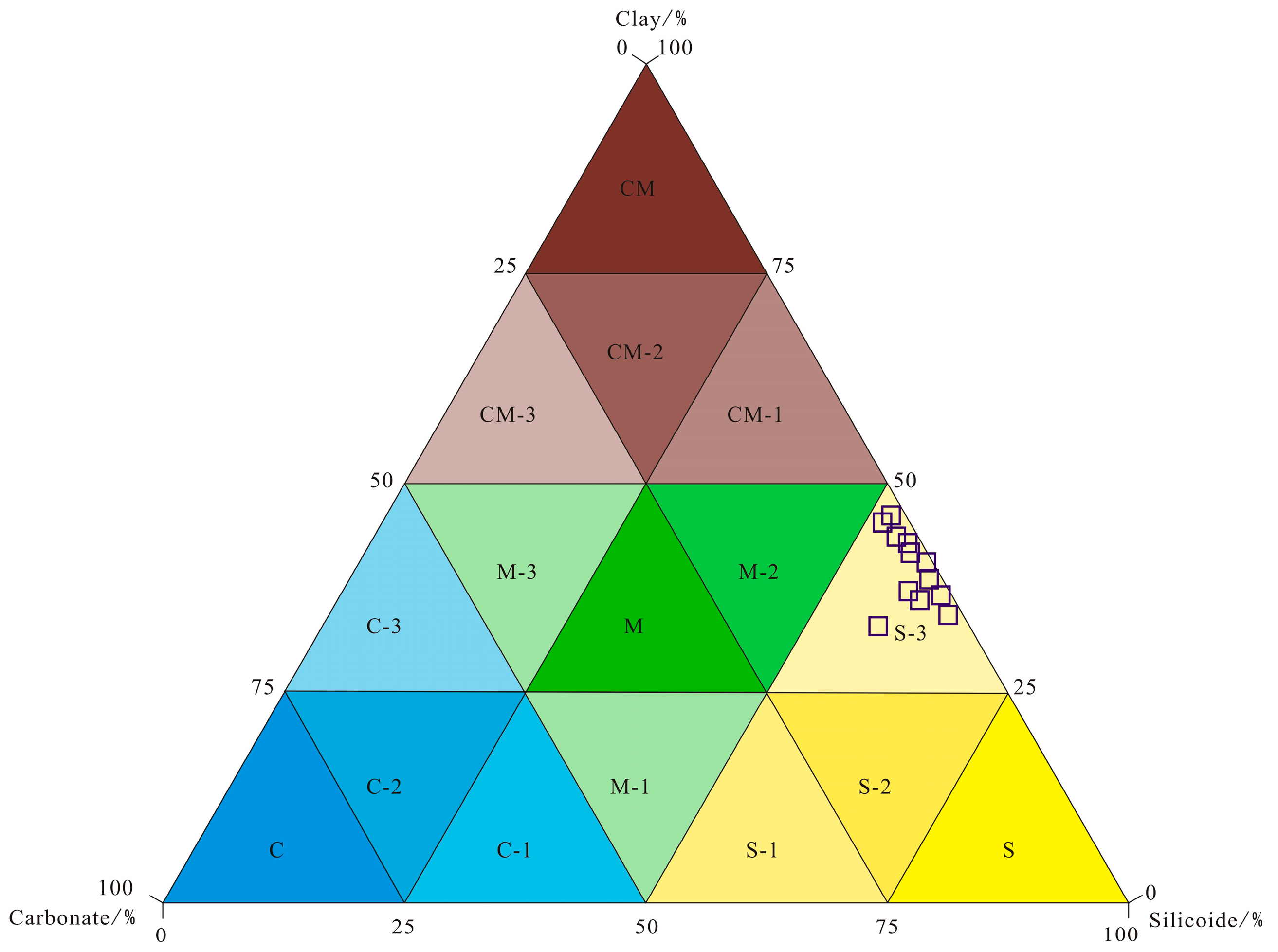
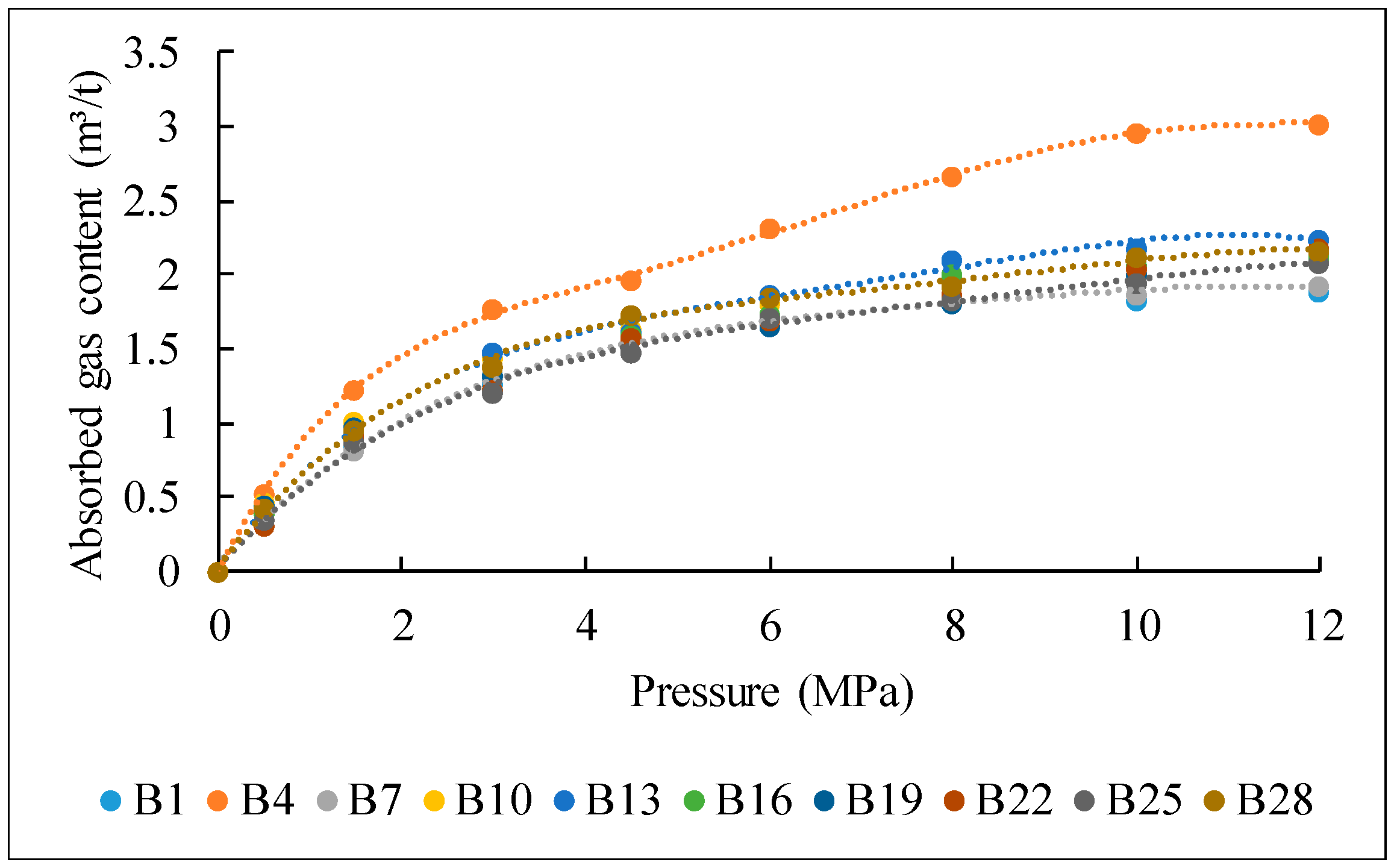
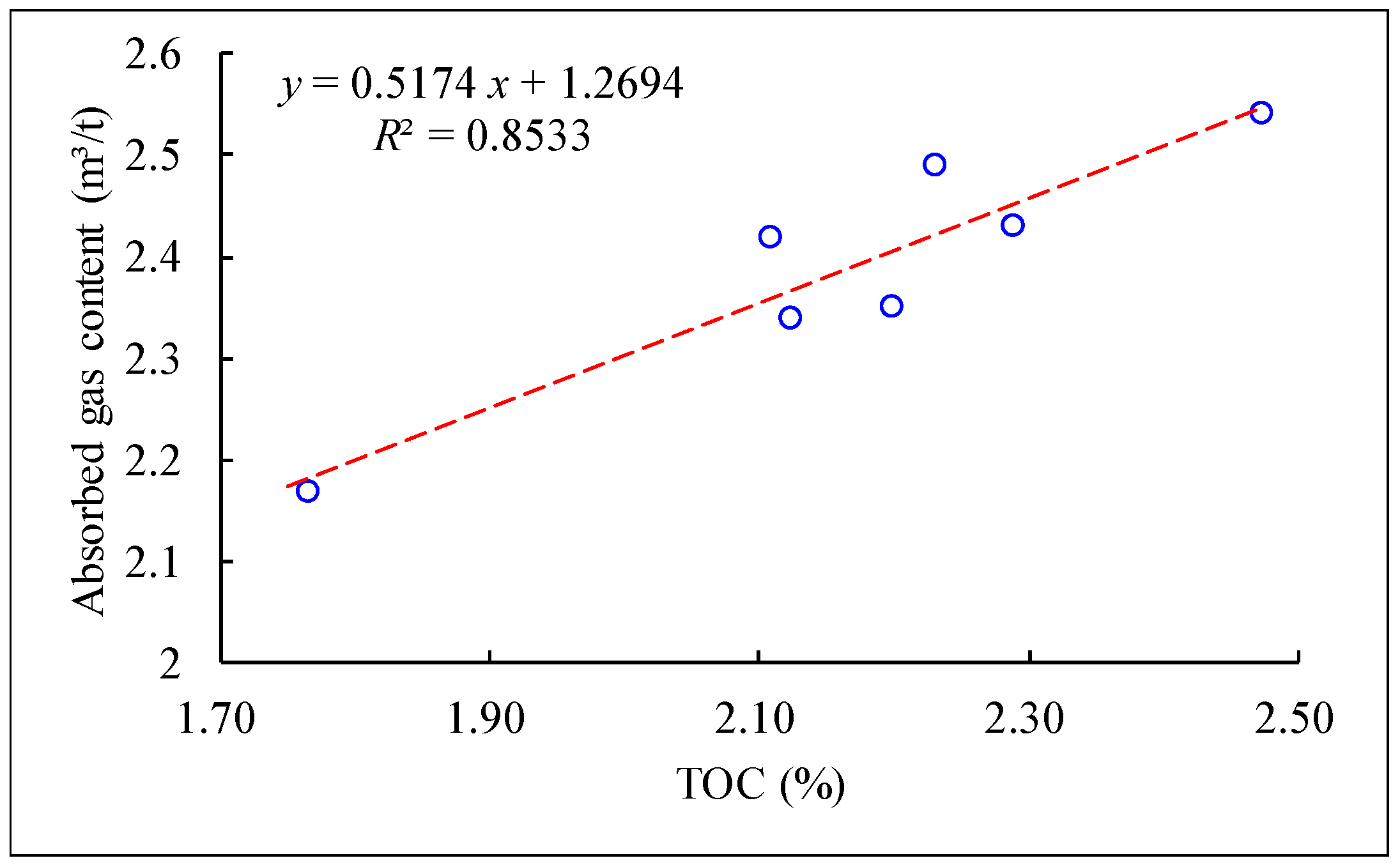
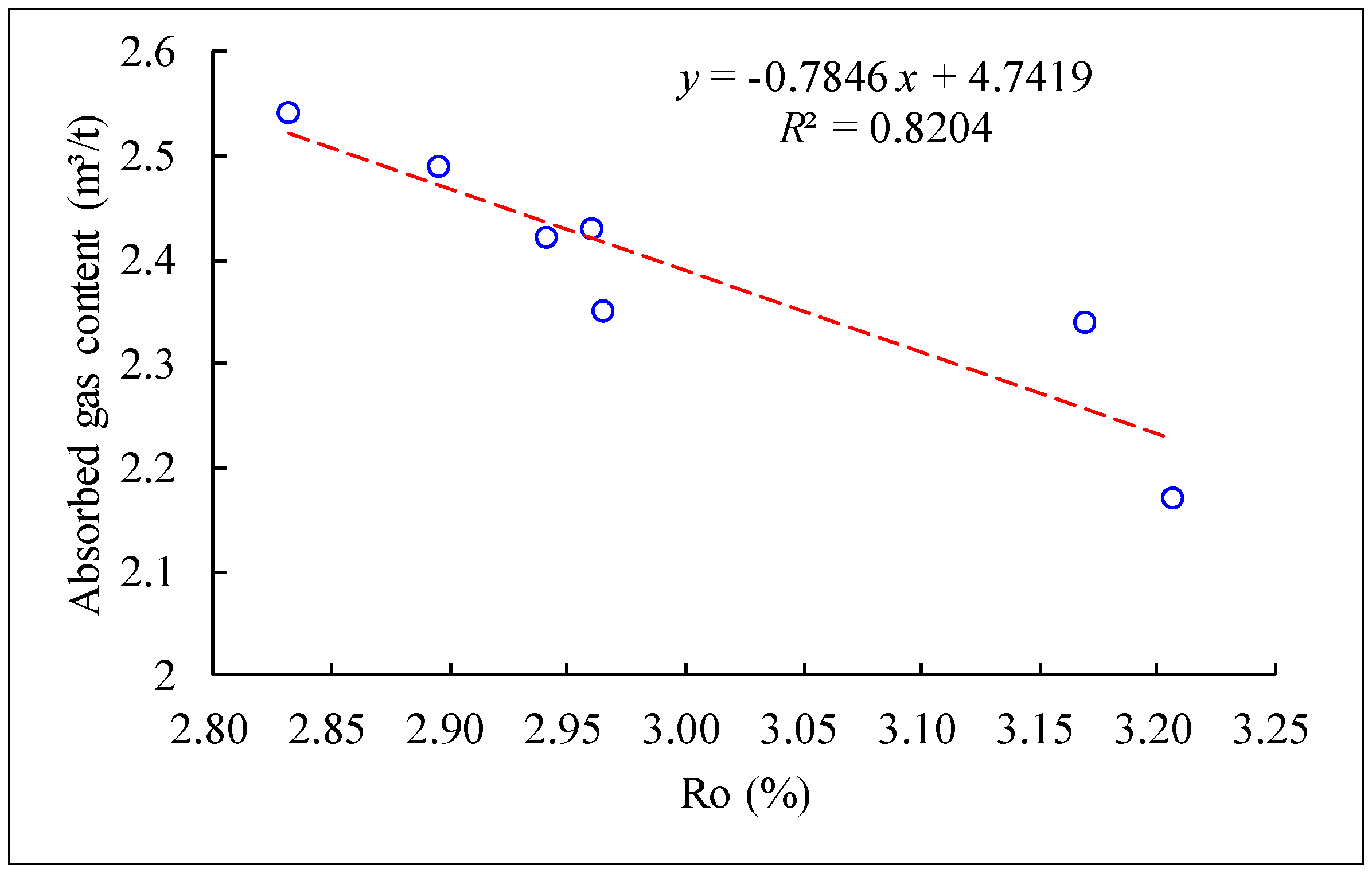
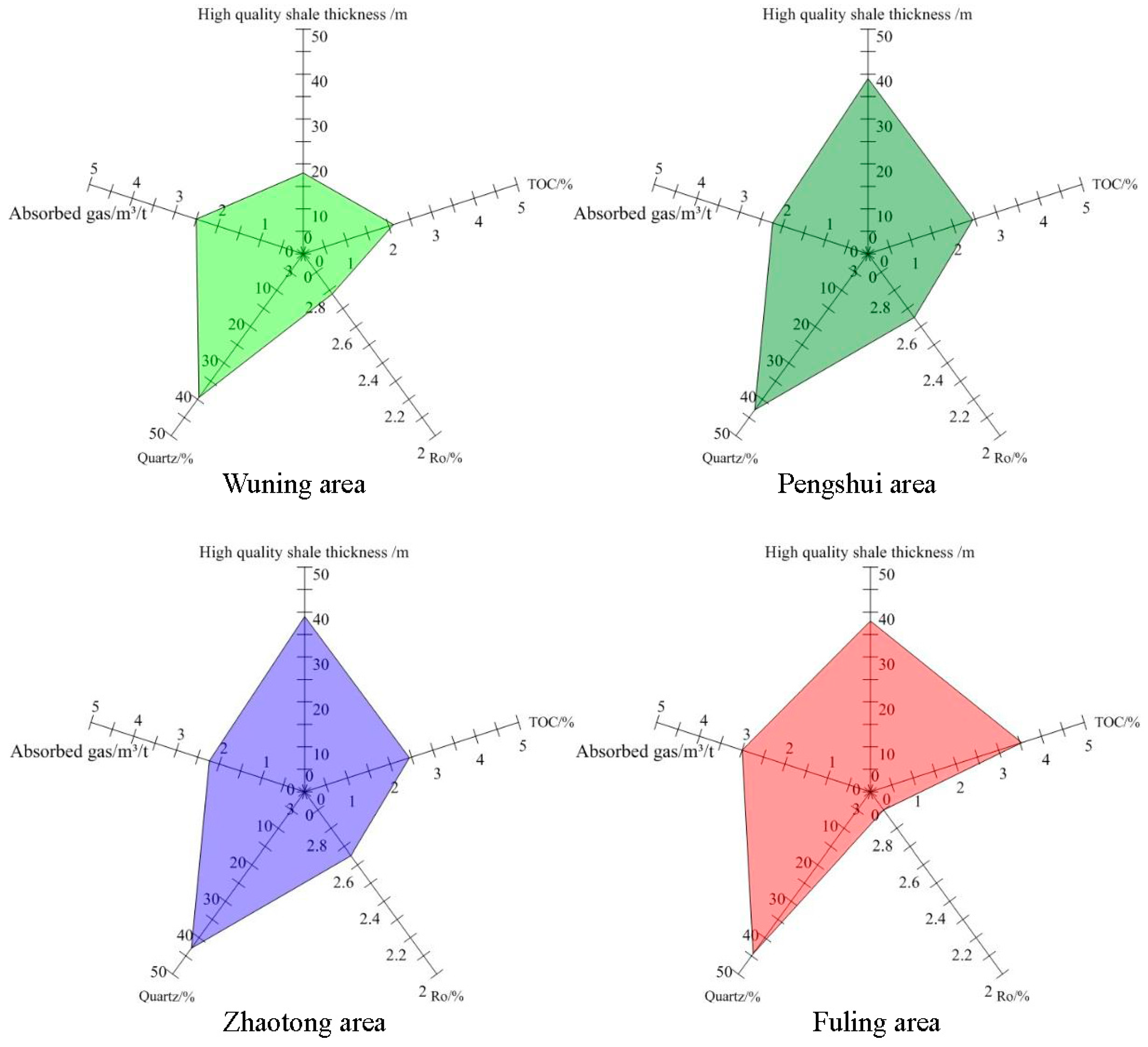

| Area | Formation | Organic Matter Type | TOC (%) | Ro (%) |
|---|---|---|---|---|
| Wuning | Xinkailing | I, II | 1.18–3.11 | 2.83–3.21 |
| Weiyuan-Rongxian | Longmaxi | I, II 1 | 1.09–6.51 | 2.41–2.64 |
| Fuling | I | 1.04–5.89 | 2.42–2.8 | |
| Jingyan-Qianwei | Qiongzhushi | I | 1.15–3.55/1.87 | 2.64–3.0 |
| Weiyuan | I | 2.0–4.2 | 2.8–3.6 |
| Area | Formation | Porosity (%) | Permeability (md) | Reservoir Space Type | Pore Size | Brittle Mineral (%) | Lithofacies | Isothermal Adsorption Volume (m3/t) |
|---|---|---|---|---|---|---|---|---|
| Wuning | Xinkailing | 1.10~1.22/1.16 | 0.000445~ 0.001297 | Organic pores Net-shaped fractures | Meso pores and Macro pores | 51.6~56.06 | Clay-rich siliceous shale | 2.12~3.47/2.5 |
| Fuling | Longmaxi | 1.17~7.98/4.8 | 0.0038~ 0.9813 | Organic pores Net-shaped fractures | Meso pores | 62.42~64.76 | Mixed siliceous shale Clay-rich siliceous shale | 0.98~6.89/3 |
© 2017 by the authors. Licensee MDPI, Basel, Switzerland. This article is an open access article distributed under the terms and conditions of the Creative Commons Attribution (CC BY) license (http://creativecommons.org/licenses/by/4.0/).
Share and Cite
Li, S.; Zeng, L.; Wang, Z.; Zhang, J.; Ma, D. A New Insight into Shale-Gas Accumulation Conditions and Favorable Areas of the Xinkailing Formation in the Wuning Area, North-West Jiangxi, China. Energies 2018, 11, 12. https://doi.org/10.3390/en11010012
Li S, Zeng L, Wang Z, Zhang J, Ma D. A New Insight into Shale-Gas Accumulation Conditions and Favorable Areas of the Xinkailing Formation in the Wuning Area, North-West Jiangxi, China. Energies. 2018; 11(1):12. https://doi.org/10.3390/en11010012
Chicago/Turabian StyleLi, Shangru, Li Zeng, Zhongpeng Wang, Jinchuan Zhang, and Dong Ma. 2018. "A New Insight into Shale-Gas Accumulation Conditions and Favorable Areas of the Xinkailing Formation in the Wuning Area, North-West Jiangxi, China" Energies 11, no. 1: 12. https://doi.org/10.3390/en11010012




